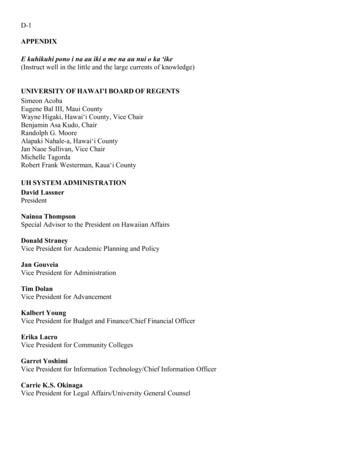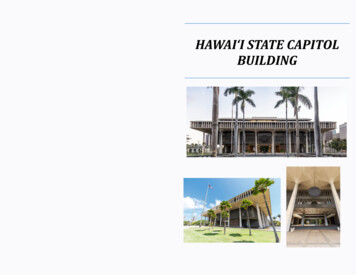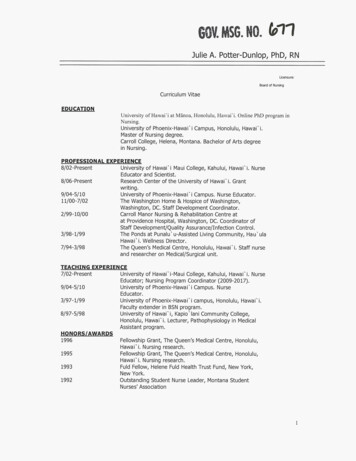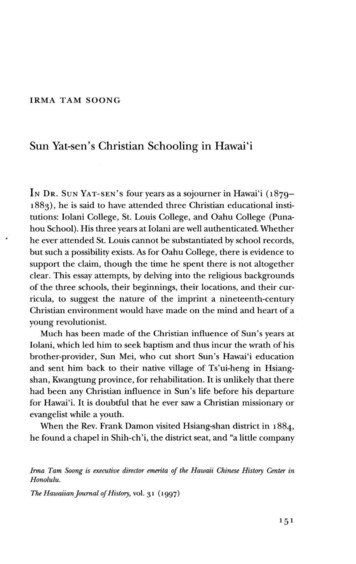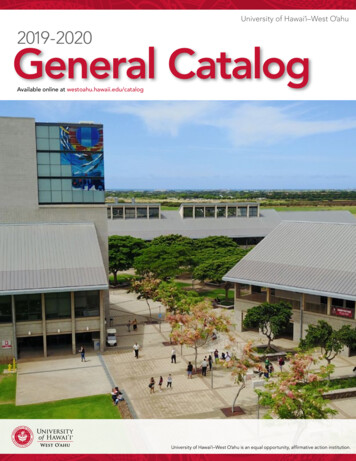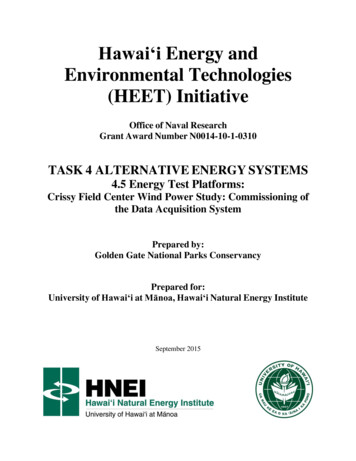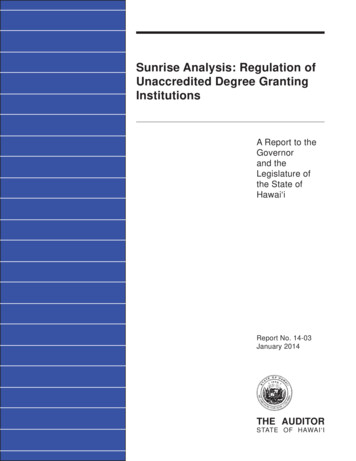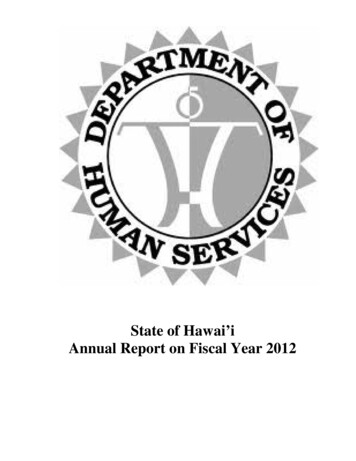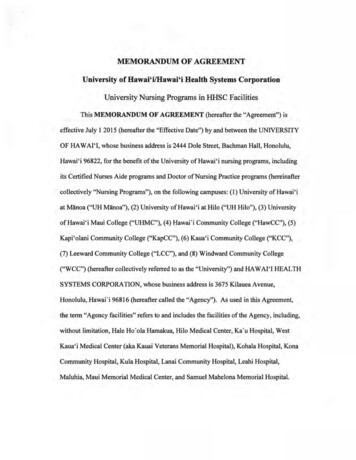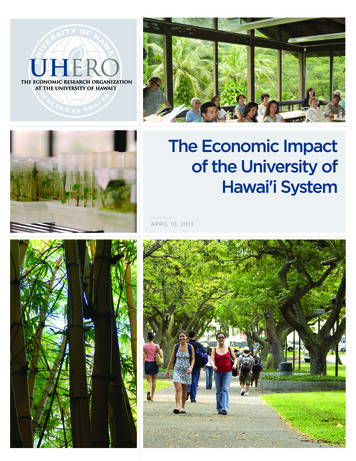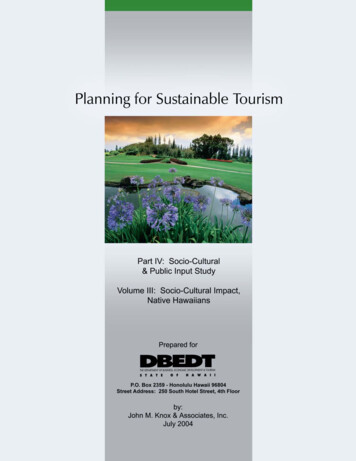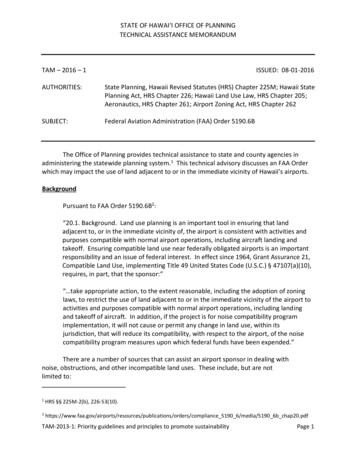
Transcription
STATE OF HAWAIʻI OFFICE OF PLANNINGTECHNICAL ASSISTANCE MEMORANDUMTAM – 2016 – 1ISSUED: 08-01-2016AUTHORITIES:State Planning, Hawaii Revised Statutes (HRS) Chapter 225M; Hawaii StatePlanning Act, HRS Chapter 226; Hawaii Land Use Law, HRS Chapter 205;Aeronautics, HRS Chapter 261; Airport Zoning Act, HRS Chapter 262SUBJECT:Federal Aviation Administration (FAA) Order 5190.6BThe Office of Planning provides technical assistance to state and county agencies inadministering the statewide planning system.1 This technical advisory discusses an FAA Orderwhich may impact the use of land adjacent to or in the immediate vicinity of Hawaii’s airports.BackgroundPursuant to FAA Order 5190.6B2:“20.1. Background. Land use planning is an important tool in ensuring that landadjacent to, or in the immediate vicinity of, the airport is consistent with activities andpurposes compatible with normal airport operations, including aircraft landing andtakeoff. Ensuring compatible land use near federally obligated airports is an importantresponsibility and an issue of federal interest. In effect since 1964, Grant Assurance 21,Compatible Land Use, implementing Title 49 United States Code (U.S.C.) § 47107(a)(10),requires, in part, that the sponsor:”“ take appropriate action, to the extent reasonable, including the adoption of zoninglaws, to restrict the use of land adjacent to or in the immediate vicinity of the airport toactivities and purposes compatible with normal airport operations, including landingand takeoff of aircraft. In addition, if the project is for noise compatibility programimplementation, it will not cause or permit any change in land use, within itsjurisdiction, that will reduce its compatibility, with respect to the airport, of the noisecompatibility program measures upon which federal funds have been expended.”There are a number of sources that can assist an airport sponsor in dealing withnoise, obstructions, and other incompatible land uses. These include, but are notlimited to:1HRS §§ 225M-2(b), /publications/orders/compliance 5190 6/media/5190 6b chap20.pdfTAM‐2013‐1: Priority guidelines and principles to promote sustainabilityPage 1
a. Hazardous Wildlife Attractants on or Near Airports, AC 150/5200-33B, August 28,2007.3b. Construction or Establishment of Landfills near Public Airports, AC 150/520034A, January 26, 2006.c. Federal and State Coordination of Environmental Reviews for AirportImprovement Projects. (RTF format) – Joint Review by Federal AviationAdministration and National Association of State Aviation Officials (NASAO),issued March 2002.4d. Land Use Compatibility and Airports, a Guide for Effective Land Use Planning(PDF format), issued by the FAA Office of Environment and Energy.5e. Compatible Land Use Planning Initiative (PDF format), 63 Fed. Reg. 27876, May21, 1998.6f. A Model Zoning Ordinance to Limit Height of Objects Around Airports, Advisory Circular(AC) 150/5190-4A.g. Glint/Glare Hazards, Airport Airspace Analysis (iOE/AAA), Combined Federal RegulationCFR Part 77 (e-CFR format) – Current as of December 15, 2015 (same as obstructionprocess below).h. Obstruction Evaluation/Airport Airspace Analysis (iOE/AAA), Combined FederalRegulation CFR Part 77 (e-CFR format) – Current as of December 15, 2015.i. Avigation and Noise Easements – Permitting agencies shall ensure that allpermits issued to projects near airports are compatible with avigation easementagreements between the State of Hawaii Department of Transportation, AirportsDivision (DOT-A) and property owners. These easements grant the DOT-A theright of flight of aircrafts, the safe operations of airports, and acceptance ofcertain noise levels and other phenomena associated with the airport. The rightto flight includes the prevention of wildlife hazard through appropriatemitigation and monitoring. In all land-use zone changes, this easement isrequired and must satisfy DOT-A edia/advisory circular/150-5200-33B/150 5200 -report.pdf5http://www.faa.gov/about/office org/headquarters offices/apl/noise emissions/planning pkg/FR-1998-05-21/pdf/98-13577.pdf4TAM‐2016‐1: Federal Aviation Administration (FAA) Order 5190.6BPage 2
Pertinent Information from FAA’s Land-Use Practices on or near Airports ThatPotentially Attract Hazardous Wildlife, Glint/Glare Hazards and Obstruction Hazards:2-1. General. The wildlife attracted to the airport environment vary considerably,depending on several factors, including land-use practices on or near the airport. Otherhazards that attract wildlife include glint/glare hazards, certain street and propertylighting designs, and aerial obstruction hazards, all of which threaten aviation safety. Inaddition to the specific considerations outlined below, airport operators should refer toWildlife Hazard Management at Airports, Glint/Glare, and Obstruction guidancematerials prepared by the FAA.Pertinent Information from FAA Order 5190.6B Compatible Land Use and Airspace Protection:4-3. Other Land-Use Practice Changes. As a matter of policy, the FAA encouragesoperators of public-use airports who become aware of proposed land use practicechanges that may attract hazardous wildlife within 5 statute miles of their airports, toinclude glint/glare hazards and aerial obstructions to promptly notify the FAA. The FAAalso encourages proponents of such land use changes to notify the FAA as early in theplanning process as possible. Advanced notice affords the FAA an opportunity (1) toevaluate the effect of a particular land-use change on aviation safety and (2) to supportefforts by the airport sponsor to restrict the use of land next to or near the airport touses that are compatible with the airport.Land use practices that may attract hazardous wildlife, and may also be a glint/glarehazard or an aerial obstruction hazard to existing flight paths include, but are not limitedto: Underwater waste dischargesAquaculture activities conducted outside of fully enclosed buildingsWater features on properties such as fountains or ponds, areas of permanent ortemporary standing water, and furrow irrigation and drainage systemsLandfills and material recycling/processing facilitiesPhotovoltaic/Solar panelsUtility poles and linesWind turbinesAntenna towersHigh rise building structuresCranesTethered Air Balloon DevicesStreet and exterior property lightsCertain landscape, trees, and ground coverTAM‐2016‐1: Federal Aviation Administration (FAA) Order 5190.6BPage 3
4-3.a. Airports that have received Federal grant-in-aid assistance are required by theirgrant assurances to take appropriate actions to restrict the use of land next to or nearthe airport to uses that are compatible with normal airport operations. The FAArecommends that airport operators to the extent practicable oppose off-airport landuse changes or practices within the separations identified in Sections 1-2 through 1-4that may attract hazardous wildlife, and/or be glint/glare, and/or obstruction hazards.Failure to do so may lead to noncompliance with applicable grant assurances. The FAAwill not approve the placement of airport development projects pertaining to aircraftmovement in the vicinity of hazardous wildlife attractants, or where glint/glare and/orobstruction hazards exist without appropriate mitigating measures. Increasing theintensity of wildlife control efforts is not a substitute for eliminating or reducing aproposed wildlife hazard, nor is the placement adjustments to mitigate glint/glare andobstruction hazards. Airport operators should identify hazardous wildlife, glint/glare,and obstruction hazards during any planning process for new airport developmentprojects.Pertinent Information from FAA 14 Code of Federal Regulation Part 77 Safe, EfficientUse and Preservation of the Navigable Airspace:7460-1 Notice of Proposed Construction or Alteration – Requirement to file §77.9Construction or alteration requiring notice.If requested by the FAA, or if you propose any of the following types of construction oralteration, you must file notice with the FAA of:(a) Any construction or alteration that is more than 200 ft. above ground level (AGL) atits site.(b) Any construction or alteration that exceeds an imaginary surface extending outwardand upward at any of the following slopes:(1) 100 to 1 for a horizontal distance of 20,000 ft. from the nearest point of thenearest runway of each airport described in paragraph (d) of this section with itslongest runway more than 3,200 ft. in actual length, excluding heliports.(2) 50 to 1 for a horizontal distance of 10,000 ft. from the nearest point of thenearest runway of each airport described in paragraph (d) of this section with itslongest runway no more than 3,200 ft. in actual length, excluding heliports.(3) 25 to 1 for a horizontal distance of 5,000 ft. from the nearest point of thenearest landing and takeoff area of each heliport described in paragraph (d) ofthis section.(c) Any highway, railroad, or other traverse way for mobile objects, of a height which, ifadjusted upward 17 feet for an Interstate Highway that is part of the NationalSystem of Military and Interstate Highways where overcrossings are designed for aminimum of 17 feet vertical distance, 15 feet for any other public roadway, 10 feetor the height of the highest mobile object that would normally traverse the road,whichever is greater, for a private road, 23 feet for a railroad, and for a waterway orany other traverse way not previously mentioned, an amount equal to the height ofTAM‐2016‐1: Federal Aviation Administration (FAA) Order 5190.6BPage 4
the highest mobile object that would normally traverse it, would exceed a standardof paragraph (a) or (b) of this section.NOTE(a) You must submit this form at least 45 days before the start date of the proposedconstruction or alteration or the date an application for a construction permit is filed,whichever is earliest.(b) If you propose construction or alteration that is also subject to the licensing requirementsof the Federal Communications Commission (FCC), you must submit notice to the FAA on orbefore the date that the application is filed with the FCC.(c) If you propose construction or alteration to an existing structure that exceeds 2,000 ft. inheight above ground level (AGL), the FAA presumes it to be a hazard to air navigation thatresults in an inefficient use of airspace. You must include details explaining both why theproposal would not constitute a hazard to air navigation and why it would not cause aninefficient use of airspace.(d) The 45-day advance notice requirement is waived if immediate construction or alteration isrequired because of an emergency involving essential public services, public health, orpublic safety. You may provide notice to the FAA by any available, expeditious means. Youmust file a completed FAA Form 7460–1 within 5 days of the initial notice to the FAA.Outside normal business hours, the nearest flight service station will accept emergencynotices.(e) There is a Notice Criteria Tool sAction.jsp?action showNoNoticeRequiredToolForm on the left margin of the webpage. It is free and will help to determine ifproposed structures need to filed for aeronautical review.Photovoltaic and Solar Farms concerns about hazards to safe air navigation from:1. Potential glare and glint caused by parabolic troughs and heliostats that might causetemporary loss of vision to pilots on arrival or departure, or to Air Traffic Controlpersonnel in the control tower.2. Electromagnetic interference with on-and off-airport radar systems that may pick upa false signal from the metal components of the mirrors with impacts that can varybased on solar tracking activity.3. Physical penetrations of navigable airspace from power towers that extend into Part77 imaginary surfaces, terminal instrument procedures (TERPS) surfaces, or the pathof radio emitting navigational aids.4. Thermal plumes emitted by the power tower that produce unexpected upwardmoving air columns into navigable air space.5. Use your discretion to evaluate the proposed footprint to be developed. If thefootprint is approaching 1 acre, have the proponent submit a 7460-1. If its within 3nautical miles of an airport, have them submit a 7460-1.TAM‐2016‐1: Federal Aviation Administration (FAA) Order 5190.6BPage 5
Wind Farms concerns about hazards to safe air navigation from:1. Create false targets and impacts FAA long radar capabilities.2. Height of structures and propellers.3. Any wind farm proposal needs to have the proponent submit a 7460-1.ApplicationThe State of Hawaiʻi Department of Transportation, Airports Division (DOT-A)discourages such land uses that may attract hazardous wildlife within five (5) statutemiles of airport boundaries, pursuant to FAA Advisory Circular 150/5200-33B, (August28, 2007). Attached are maps depicting the five (5) statute miles from airports in theState of Hawaiʻi, including glint/glare hazards pursuant to Federal AviationAdministration Notice of Interim Policy dated October 23, 2013 and aerial obstruction toexisting flight paths pursuant to Combined Federal Regulation CFR Part 77 (e-CFRformat) – Current as of December 15,2015.State, county, and federal agencies who have jurisdiction over areas within five (5)statute miles of airport boundaries and have permit authority over future land uses thatmay attract hazardous wildlife shall consider FAA Advisory Circular 150/5200-33B,including glint/glare hazards and aerial obstruction(s) to existing flight paths inaccordance with the FAA Obstruction Evaluation/Airport Airspace Analysis (iOE/AAA),Combined Federal Regulation CFR Part 77 in their decision making on plans and permits,Consultation with the DOT-A (Airport Operations) shall be performed at the earliesttime where a future land use that may attract hazardous wildlife, glint/glare hazard oraerial obstruction(s) is proposed. Agencies should inform applicants of permits orapprovals of such proposed land uses to consult with the DOT-A (Airport Operations) assoon as possible, pursuant to the Airport Zoning Act HRS Chapter 262.Where applicable, when a land-owner petitions the State of Hawaii Land UseCommission (LUC) with a request for a land use district boundary amendment, the Statewill propose an LUC condition requiring an avigation and noise easement be granted toDOT-A and the terms of the easement must meet the requirements of the DOT-A,including mitigation to minimize potential wildlife hazards to aircrafts and airportoperations.In cases where the respective counties are the authority for land use district boundaryamendments (petitions under fifteen (15) acres), the respective counties should contactDOT-A for any requirements of an avigation and noise easement.TAM‐2016‐1: Federal Aviation Administration (FAA) Order 5190.6BPage 6
When a landowner in the vicinity of the airport pursues redevelopment of a property,the landowner must grant an avigation and noise easement to the DOT-A to ensurecompatible land use in the vicinity of the airport. The terms of the easement mustsatisfy DOT-A requirements.Grant of avigation and noise easements to DOT-A is necessary for the safety of airtransportation which is a public benefit. State, County, and Federal regulatory andservice agencies that work with any aspect of the conditions identified in an avigationand noise easement must take appropriate actions and incorporate the DOT-A avigationeasement requirements in their decisions.Office of PlanningState of HawaiʻiP.O. Box 2359Honolulu, HI 96804Phone: (808) 587-2846Web: planning.hawaii.govDepartment of TransportationAirports DivisionState of Hawaiʻi400 Rodgers Boulevard, Suite 700Honolulu, HI 96819-1880Phone: (808) 838-8810Note: A Technical Assistance Memorandum (TAM) is an informational statement of the law,regulations, or policies. It is accurate on the date issued. Subsequent changes in the law or regulations,judicial decisions, or changes in policies could affect the validity of the information presented in a TAM.TAM‐2016‐1: Federal Aviation Administration (FAA) Order 5190.6BPage 7
OTAirportsihuePort dthelimitationsofthedata. lAirport
patialanalysisbeyondthelimitationsofthedata. awaii,DOT,2014.02.5510Miles
sbeyondthelimitationsofthedata. awaii,DOT,2014.2.5510Miles
irportsMolokaiAirportKalaupapaAirport0 2.5 edata. awaii,DOT,2014.HanaAirport
Hawaii ndthelimitationsofthedata. awaii,DOT,2014.0HiloInternationalAirport51020Miles
System of Military and Interstate Highways where overcrossings are designed for a minimum of 17 feet vertical distance, 15 feet for any other public roadway, 10 feet or the height of the highest mobile object that would normally traverse the road, whichever is greater, for a private road, 23 feet for a railroad, and for a waterway or
